Previous: Laura McPhee at the MFA (29)
On Stage in Osaka and Tradition and Transformation at the MFA
Post #805 • June 7, 2006, 12:38 PM • 15 Comments
On Stage in Osaka presents fifty woodcut prints pulled from the MFA's collection of 1500 of them - and that's just the images produced in Osaka. Press materials accompanying the exhibition report that some others are laying about as well:
These are among thousands of previously uncatalogued prints believed to have been part of a massive gift from William Sturgis Bigelow in 1911. Now, almost 100 years later, they are being recorded, photographed, researched and exhibited for the first time as part of the MFA's Japanese Print Access and Documentation Project whose long-term goal is to photograph and catalogue the Museum's entire collection of some 50,000 Japanese prints and make them available to the public on the MFA Web site at www.mfa.org.
Mr. Calculator tells me that with that many prints, you could spend a year looking at 136 of them a day without repeating any. Go, MFA.
Osaka prints tended to concentrate on kabuki theater, a kaleidoscopic pageant of performance and costuming. You could devote your life to learining about the narratives, which involve heroes, maidens, demons, ghosts, betrayals, suicides, swordfights - the whole arsenal of myth played out with over-the-top exuberance, wild make-up, and sophisticated special effects that made Osaka famous country-wide for its shows. Describing the prints requires superlatives that grate on my sensibilities as a writer, but nothing less will do: exquisite draftsmanship, knockout design, luscious coloration, charming expressiveness, the whole nine yards, although a few of them, admittedly, look pretty odd.
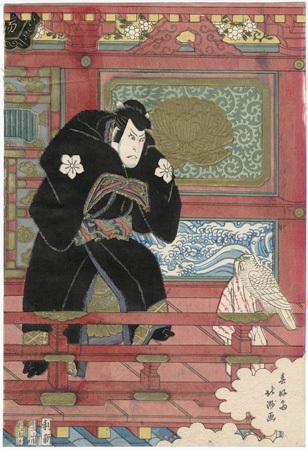
Shunkosai Hokushu, Japanese, active 1810-1832: Actor Nakamura Utaemon III (Shikan) as Ishikawa Goemon, Publisher: Tokuraya Shinbei (Toshin), Japanese, Engraver: Yamaichi, Japanese, active 1822-1824, Printer: Matsumura Kinji, Japanese, active 1822-1826, Japanese, Edo period, 1822 (Bunsei 5), 2nd month, Woodblock print (nishiki-e); ink and color on paper, Museum of Fine Arts, Boston. William Sturgis Bigelow Collection, Photograph © Museum of Fine Arts, Boston
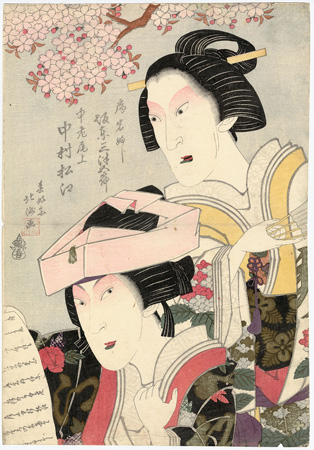
Shunkosai Hokushu, Japanese, active 1810-1832: Actors Bando Mitsugoro III as Lady Iwafuji and Nakamura Matsue III as Churo Onoe, Japanese, Edo period, 1821 (Bunsei 4), 1st month, Woodblock print (nishiki-e); ink and color on paper, Museum of Fine Arts, Boston. William Sturgis Bigelow Collection, Photograph © Museum of Fine Arts, Boston
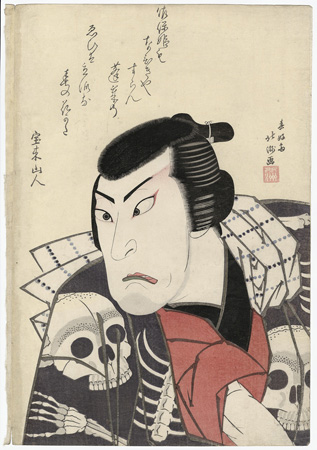
Shunkosai Hokushu, Japanese, active 1810-1832: Actor Ichikawa Ebijuro I as Token Jubei, Japanese, Edo period, about 1822 (Bunsei 5), 1st month, Woodblock print (nishiki-e); ink and color on paper, Museum of Fine Arts, Boston. William Sturgis Bigelow Collection, Photograph © Museum of Fine Arts, Boston
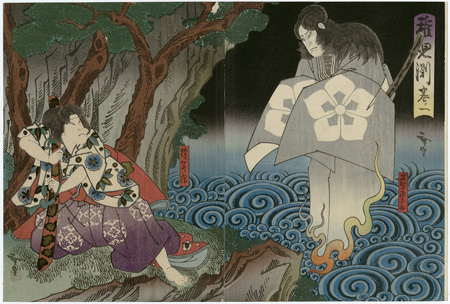
Gosotei Hirosada, Japanese, active 1826-1863, died about 1865: [Actors Nakamura Utaemon IV as] Takechi Samanosuke and [Nakamura Tamashichi as] Sutewakamaru in Chigogafuchi, Japanese, Edo period, 1852 (Kaei 5), 3rd month, Woodblock print (nishiki-e); ink and color on paper, Museum of Fine Arts, Boston. William Sturgis Bigelow Collection, Photograph © Museum of Fine Arts, Boston
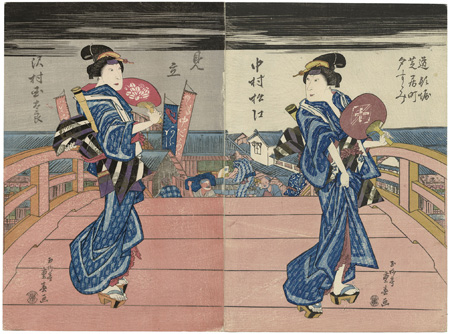
Gyokuryutei Shigeharu, Japanese, 1803-1853: Enjoying the Evening Cool in the Theater District at Dotonbori: An Imaginary Scene (Dotonbori Shibai-machi yusuzumi, mitate), with Actors Nakamura Matsue III (R) and Sawamura Kunitaro II (L), Japanese, Edo period, 1832 (Tenpo 3), 6th month, Woodblock print (nishiki-e); ink and color on paper, Museum of Fine Arts, Boston. William Sturgis Bigelow Collection, Photograph © Museum of Fine Arts, Boston
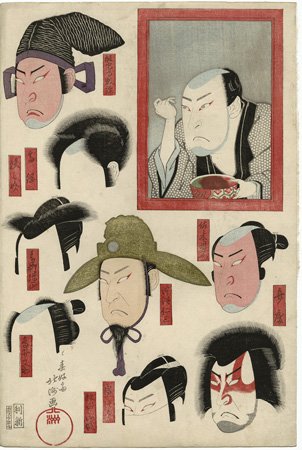
Shunkosai Hokushu, Japanese, active 1810-1832: Actor Arashi Kitsusaburo I (Rikan) in the dressing room mirror, with wigs and makeup for various roles, from an untitled series of five, Japanese, Edo period, about 1821 (Bunsei 4), Woodblock print (nishiki-e); ink and color on paper, Museum of Fine Arts, Boston. William Sturgis Bigelow Collection, Photograph © Museum of Fine Arts, Boston
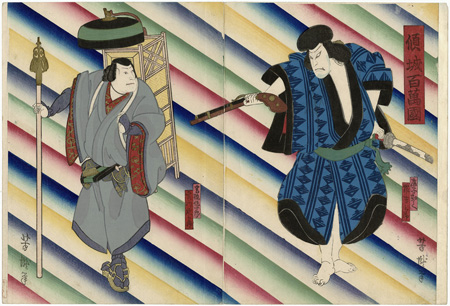
Ichiyosai Yoshitaki, Japanese, 1841-1899: Actors Arashi Kichisaburo III as Kanoko Kanbei (R) and Jitsukawa Enzaburo I as Takahashi Sakujuro (L), Japanese, Edo period, 1864 (Bunkyu 4), 1st month, Woodblock print (nishiki-e); ink and color on paper, Museum of Fine Arts, Boston. William Sturgis Bigelow Collection, Photograph © Museum of Fine Arts, Boston
The museum, seemingly unused to blogger-level scrutiny, had no images available for another show in the Japanese rooms, Tradition and Transformation: Japanese Art 1860-1940. Awed by Matthew Perry's stern diplomacy and ferocious gunships, Japan abandoned isolationism after his arrival in 1853, and artistic ideas quickly began to flow both orientally and occidentally. This exhibition features Japanese works that picked up Western influences, and not just traditional prints of daimyo and their families wearing British fashions, although there's a bit of that too. Japanese artists, informed by Western reproductions and art magazines, experimented joyfully with materials and absorbed Art Nouveau as easily as if they had invented it. Notable works include Tomioka Eisen's print of boys playing baseball, Mishima Shoso's pigeons, rendered with Audobon-level realism as they perch among leaves painted with broad strokes of black ink, and Shibata Zeshin's puppies painted on primed paper in lacquer, which makes a black darker than ink itself.
The show dedicates the last room mostly to Hashiguchi Goyo and Onchi Koshiro. Goyo trained in Western-style painting, and a pencil drawing of a nude shows the enormous degree to which he mastered it. When he turned to ukiyo-e, he produced some of the finest examples of female depiction in the history of Japanese art, beautiful as such images always are, but psychological in a way they often aren't. Koshiro took inspiration from Munch, and two images of bathers show him working with breathtaking simplicity. This room may be the best one in the museum at the moment, and the exhibition deserves more play than it's getting.
On Stage in Osaka: Actor Prints from the MFA Collection runs through January 3, 2007. Tradition and Transformation: Japanese Art 1860-1940 runs through November 9, 2006.
2.
June 7, 2006, 12:56 PM
Good catch. It's fixed.
3.
June 7, 2006, 1:23 PM
Oh, and JL - when we start Feend, I think we should use that image of Ichikawa Ebijuro as our fashion plate.
4.
June 7, 2006, 2:14 PM
You're sure it's not a little too Goth?
6.
June 7, 2006, 6:04 PM
Massive gift is right. I can't believe it's taken them this long to get around to them. If you ask me, they didn't deserve them in the first place, though I suppose better late than never.
7.
June 7, 2006, 6:22 PM
Come on, Jack. The reason ukiyo-e got noticed in the first place is because they were using them to wrap ceramics for shipment. It's been a long, tough road.
8.
June 7, 2006, 6:39 PM
So these are one-stage monochrome woodblock black ink prints which have then been brushed with coloured ink? But some of the coloured parts seem to be woodblock printed too, so I'm a little unsure of what the process is. And how nishiki-e is different from ukiyo-e.
Very pleasing images, I must type. I think the ...dressing room mirror with wigs... is my favourite.
And if I may nit-pick... how does pencil drawing demonstrate Goyo's mastery of Western-style painting?
Good post, Franklin.
9.
June 7, 2006, 6:44 PM
Well, the guy who collected them and gave them to the MFA must have thought they were museum-worthy, and that was in 1911. The artistic merit of these prints was common currency in western art circles decades before that. Sorry, Franklin, your excuse does not apply.
10.
June 7, 2006, 7:08 PM
No excuses, Jack, just pointing out that they went through a process of that changed them from Victorian bubble wrap to precious cultural objects and that it didn't happen in a week.
Ahab, ukiyo-e referst to the genre, nishiki-e refers to the technique. It's a pure woodblock print technique, so the colors are printed as well.
Okay, I guess my statement about Goyo is not technically logical. He certainly mastered Western drawing, though.
11.
June 7, 2006, 7:32 PM
I agree that those otherwise gratuitous and cliche superlatives you resorted to were necessary and apt. Except maybe "the whole nine yards".
Tradition and Transformation sounds like a wonderful show, and if images were to come available online, that'd be great.
12.
June 7, 2006, 7:37 PM
Many, though not all, of these objects have almost probably been photographed and cataloged to some degree in the past. But a photograph from 1911 isn't what one wants to work now (except for conservation or research purposes into the past state of the object), nor will research done at that time necessarily hold up or answer questions we want answered today. And as the work done ages, and museum staff turns over, there's often a loss of institutional memory that can make some of what was done in the past obscure. They are talking about a massive undertaking; museums of any decent size are likely to have collections that have not received the attention they deserve, and to give it systematically like this is very difficult.. It takes a lot of manpower, which museums--even big, well-funded ones like the MFA--don't always have. Prints from the Bigelow collection have been featured in exhibitions frequently over the years. It's a different thing to try and do authoritative cataloging of that many objects.
13.
June 7, 2006, 7:54 PM
If I gave a collection like this to a museum, I'd sure as hell expect better, and I'd make sure of that before I gave it. That may not necessarily guarantee things, since no doubt there are many instances where a donor's wishes were not respected, certainly not the way the donor had in mind. Bigelow would have probably done better to divide the gift between different museums; some lower-profile places than the MFA might well have been more appreciative and more attentive.
14.
June 7, 2006, 8:29 PM
The choice to donate a gift of thousands of works to a single institution makes me think that swift handling of it was not the motivation, but rather a desire to build what was then still a fairly young museum for future generations. Especially considering we're dealing with works on paper, the nature of which dictates that they will spend most of their time out of sight in storage. While gifts like this one are not an everyday occurance, they're not unknown; and I doubt the process is different anywhere.
15.
June 7, 2006, 8:33 PM
Franklin
Very nice post
Makes me want to fly up to see the show.
When I look at these prints I can't help but feel that there is something contemporary about them
and that they seen to have a affinity with some of the work that I see being produced today
by younger artist. Is there some influences that I am seeing here or am I off base?
1.
JL
June 7, 2006, 12:55 PM
Are you sure that isn't Onchi Koshiro? If it is, I really like his prints. Had a chance to see a few of them, including Lyric No. 2, a couple of years ago. That sort of Japanese modernism seems like a rather underexplored area--to me, at any rate. For those who are more involved with it, it may seem old hat.